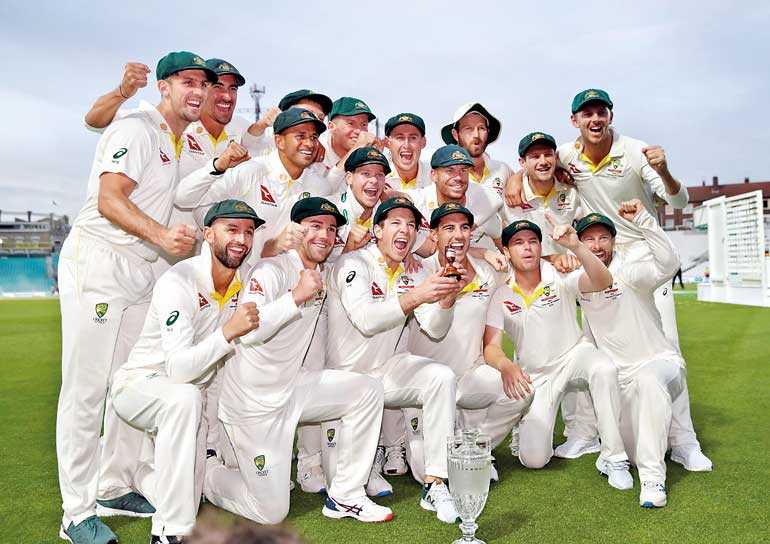Monday Apr 21, 2025
Monday Apr 21, 2025
Tuesday, 17 September 2019 01:09 - - {{hitsCtrl.values.hits}}

Australia players celebrate with the Ashes trophy and urn after drawing the series to retain the Ashes - Action Images via Reuters
London (Reuters): Sustained excellence from Steve Smith, who scaled new heights with 774 runs, complemented by the searing pace and accuracy of Pat Cummins and Josh Hazlewood enabled Australia to cling on to the Ashes despite losing the final test against England on Sunday by 135 runs.
Smith, the former captain who returned to the national side for this year’s World Cup and Ashes after he was suspended for his part in a ball-tampering scandal in South Africa, finally fell to earth when he was out for 23 in Australia’s second innings on a glorious sun-drenched autumn afternoon at The Oval.
With his departure, greeted with generous applause from a capacity crowd aside from a few scattered boos, Australia’s faint hopes of reaching a victory target of 399 also vanished despite a battling century from Matthew Wade.
However, victory in the fourth test at Old Trafford meant the Australians could not lose the series and the 2-2 scoreline meant they retained the urn.
It was the first drawn Ashes series since 1972 when Ian Chappell’s Australians squared the series 2-2 at the same London venue.
Smith, who missed the third test after he was concussed by a blow to the neck at Lord’s, scored 144, 142, 92, 211, 82 and 80 before Sunday.
Each knock was the highest for his team and the first innings at the Oval was his 10th successive score exceeding 50 against an England test attack.
In the history of test cricket only his incomparable compatriot Don Bradman, who averaged 99.94 from 52 tests, stands ahead of Smith whose average has risen to fractionally below 65.
“The series has ebbed and flowed, I’ve loved every minute and I’m proud to have been able to perform for Australia and bring the urn home,” Smith said.
“You always want to get better as a played and I’ll continue to work hard,” he said.
Smith’s prodigious scoring, with able assistance from Marnus Labuschagne who became test cricket’s first concussion substitute when he replaced Smith at Lord’s and then scored four half-centuries, helped paper over some woeful Australian upper-order batting.
David Warner, who also served a year-long suspension for the same offence as Smith, returned to the national side to score 647 runs at the World Cup where the defending champions were beaten by the home side in the semi-finals. England defeated New Zealand to win the trophy for the first time.
However, in the Ashes series the pugnacious left-handed opener, who with Smith has been the bulwark of the Australian batting in recent years, had his technique picked apart by Stuart Broad, bowling around the wicket with the new ball.
Broad dismissed Warner seven times in 10 innings, in which his average was 9.5. The average opening partnership was also in single figures and the highest stand a dismal 18.
To compensate for their batsmen’s failures, Cummins in five tests and Hazlewood in the final four took 49 wickets between them and all the England batsmen struggled against their speed and aggression.
But at the Oval even they were showing the effects of five tests in seven weeks, which was reflected in indifferent shots and uncharacteristic dropped catches, and the team will be delighted to return home for a break before the Australian season begins.
Discover Kapruka, the leading online shopping platform in Sri Lanka, where you can conveniently send Gifts and Flowers to your loved ones for any event including Valentine ’s Day. Explore a wide range of popular Shopping Categories on Kapruka, including Toys, Groceries, Electronics, Birthday Cakes, Fruits, Chocolates, Flower Bouquets, Clothing, Watches, Lingerie, Gift Sets and Jewellery. Also if you’re interested in selling with Kapruka, Partner Central by Kapruka is the best solution to start with. Moreover, through Kapruka Global Shop, you can also enjoy the convenience of purchasing products from renowned platforms like Amazon and eBay and have them delivered to Sri Lanka.
Discover Kapruka, the leading online shopping platform in Sri Lanka, where you can conveniently send Gifts and Flowers to your loved ones for any event including Valentine ’s Day. Explore a wide range of popular Shopping Categories on Kapruka, including Toys, Groceries, Electronics, Birthday Cakes, Fruits, Chocolates, Flower Bouquets, Clothing, Watches, Lingerie, Gift Sets and Jewellery. Also if you’re interested in selling with Kapruka, Partner Central by Kapruka is the best solution to start with. Moreover, through Kapruka Global Shop, you can also enjoy the convenience of purchasing products from renowned platforms like Amazon and eBay and have them delivered to Sri Lanka.